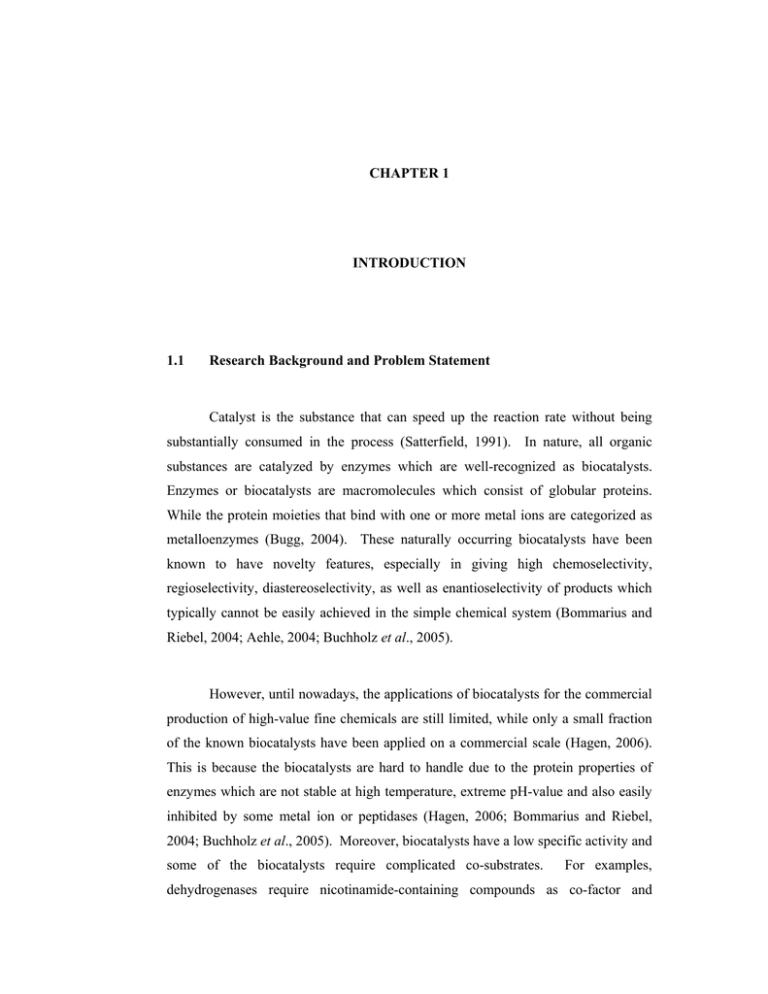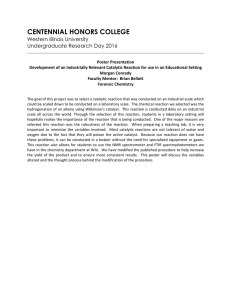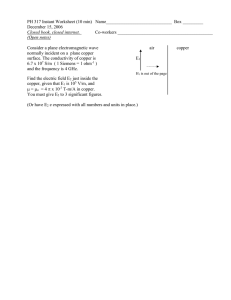Catalyst is the substance that can speed up the reaction... substantially consumed in the process (Satterfield, 1991). In nature,... CHAPTER 1
advertisement

CHAPTER 1 INTRODUCTION 1.1 Research Background and Problem Statement Catalyst is the substance that can speed up the reaction rate without being substantially consumed in the process (Satterfield, 1991). In nature, all organic substances are catalyzed by enzymes which are well-recognized as biocatalysts. Enzymes or biocatalysts are macromolecules which consist of globular proteins. While the protein moieties that bind with one or more metal ions are categorized as metalloenzymes (Bugg, 2004). These naturally occurring biocatalysts have been known to have novelty features, especially in giving high chemoselectivity, regioselectivity, diastereoselectivity, as well as enantioselectivity of products which typically cannot be easily achieved in the simple chemical system (Bommarius and Riebel, 2004; Aehle, 2004; Buchholz et al., 2005). However, until nowadays, the applications of biocatalysts for the commercial production of high-value fine chemicals are still limited, while only a small fraction of the known biocatalysts have been applied on a commercial scale (Hagen, 2006). This is because the biocatalysts are hard to handle due to the protein properties of enzymes which are not stable at high temperature, extreme pH-value and also easily inhibited by some metal ion or peptidases (Hagen, 2006; Bommarius and Riebel, 2004; Buchholz et al., 2005). Moreover, biocatalysts have a low specific activity and some of the biocatalysts require complicated co-substrates. For examples, dehydrogenases require nicotinamide-containing compounds as co-factor and 2 oxidases require flavin co-factor (Hagen, 2006; Bommarius and Riebel, 2004). From the economic point of view, biocatalysts are not the best selection as they are expensive and highly unaffordable. In addition, it may take a long development times for new enzymes and processes (Hagen, 2006; Bommarius and Riebel, 2004). Over the past few years, much effort has been put in the development of catalysts based on transition metals and their complexes (Moutet and Ourari, 1997; Salomão et al., 2007). This is because of the transition metals have vacant d-orbitals which may hybrid to bound with various types of organic molecules (Hagen, 2006; Masters, 1981). The transition metals can exist in various oxidation states which contribute to their ability to interchange their oxidation numbers during the catalytic process (Hagen, 2006). Besides that, the scientist also found that most of the metalloenzyme consists of transition metal as an active site. For example (Figure 1.1), alcohol dehydrogenase (1) contains a single zinc(II) ion at their active site, nitrous oxide reductase (2) with copper atom in active center, horseradish peroxidase (3) contains the protoheme group with an iron(III) atom in the active center and so on (Bugg, 2004; Koval et al., 2008; Veitch, 2004). Furthermore, the easier handling of such chemically synthesized catalyst is the preferred choice of manufacturers. Therefore, the catalytic reaction based on transition metal as catalyst is an attractive field for study. 3 Figure 1.1 The structure of the active site in common metalloenzyme; alcohol dehydrogenase (1), nitrous oxide reductase (2) and horseradish peroxidase (3) Copper is one of the transition metals which have been recognized as an important biological element since the identification of copper-containing active sites in numerous oxidases, oxygenases and other metalloenzymes (Horváth et al., 2004). These copper-containing proteins typically play a role as redox catalysts in a range of biological processes, such as electron transfer or oxidation of various organic substances (Koval et al., 2008). In general, copper is known to exist in the 0, +1, +2 and +3 oxidation states. Copper in zero oxidation state that is present in metal form, typically is not a reactive element. On the other hand, copper(III) which is not commonly found has been suggested as an intermediate in certain reactions involving catalytic amounts of copper(II) ion. Based on the previous research trend, copper(II) is preferably used for research more than copper(I). This may be due to the instability of copper(I) which is easily oxidized to copper(II). Furthermore, 4 copper(II) has long been found to be a good catalyst to oxidize a wide range of organic substances with high selectivity due to its mild oxidizing power and compatibility with a variety of solvent systems (Jacob et al., 1998a). Recently, copper(II) coordinated with organic ligands has been widely synthesized for oxygen uptake and catalytic studies with the aim to understand the mechanism of action of copper-containing enzyme. Schiff bases are the organic ligand which has been widely used for research purpose due to their ability to stabilize the different types and also the various oxidation states of metals (Ribeiro da Silva et al., 2004; Caselli et al., 2005). The previous studies showed that the coordination geometries adopted by copper ions vary with the oxidation state, where copper(II) ion prefers square planar, trigonal bipyramidal and tetragonal or octahedral geometries (Koval et al., 2008). Thus, tetradentate and octadentate ligands were compatible to coordinate with copper(II) ion. N,N,O,O-tetradentate Schiff base ligands possess many attractive features including facile approach, readily adjusted ancillary ligands, and tuneable steric and electronic coordination environments on the metal center (Wang et al., 2003). On the other hand, numerous known copper-containing proteins, such as galactose oxidase has the “CuN2O2” group as its active site (Jacob et al., 1998b). Salen or N,N’-bis(salicylidene)ethylenediamine is one of the members of N,N,O,Otetradentate Schiff base, which typically can be obtained by the condensation of salicylaldehyde and ethylenediamine. Copper(II) coordinated with salen and its derivatives have been the subject of intensive study due to their potential as catalysts in various oxidation reactions, including epoxidation of olefins, oxidation of phenol, etc (Jacob et al., 1998a; Jacob et al., 1998b). Flexibility of the ethylenediamine backbone in that ligand as observed in a number of transition metal complexes with bidentate oxygen ligands is responsible for the complex to mimic the biological function of enzymes (Karandikar et al., 2004; Lloret et al., 1989). 5 The increasing stringent environmental constraints have brought to the trend in designing the heterogeneous catalytic system. Direct use of the solid catalysts in the reaction is the easiest and conventional way to generate heterogeneous catalytic system. Recently, heterogenization of homogeneous catalysts has been the subject of intensive study. Heterogenization of homogeneous catalysts is a technique that involves the immobilization of homogeneous catalyst on a solid matrix (Chaube et al., 2005; Bahramian et al., 2006a). Heterogenization of homogeneous catalysts is an ideal method which combines the advantageous of homogeneous catalyst, such as high catalytic activity and product yield, with the engineering advantages of heterogeneous catalysts, including easily to recover, prolong catalytic life cycle, increase thermal stability and reusability of catalyst (Mac Leod et al., 2007; Chaube et al., 2005; Bahramian et al., 2006a; Kozlov et al., 1998; Leadbeater and Marco, 2002). Among the solid supports, ordered mesoporous silica, which is discovered by Mobil researchers, has been widely used for research studies due to its favorable features including possessing high specific surface areas, tunable pore size from 16 to 100 Å, high chemical and thermal stability as well as provides a modifiable surface (Taguchi and Schüth, 2005; Kresge et al., 1992). Mesoporous silica has been reported as a good solid support, because the porous silica does not destroy or hinder the active site of catalyst. Moreover, it can enhance the catalytic activity and selectivity of the catalyst. Over the past few years, MCM-41 has attracted a lot of attention and more preferred used as support material if compared with other mesoporous materials. This is because MCM-41 is easy to synthesize and obtainable in highly pure phase, reproducible and the framework structure is more stable. On the other hand, there are only a few of studies reported on heterogeneous catalytic reaction based on MCM-48 as support material. This three-dimensional cubic mesoporous MCM-48 which possesses narrow pore size distribution, interwoven, branched, regular cubic pore structure will offer the advantages of catalyst support, especially towards resistance to pore blockage (Ryoo et al., 1999; Xu et al., 1998). Thus, MCM-48 has been selected as solid support in this study. 6 Therefore, this study is conducted in order to investigate the catalytic properties of copper(II) diethylamino-substituted salen complex supported on MCM48 in oxidation of o-aminophenol (AP) to 2-amino-3H-phenoxazin-3-one (APX) by using aqueous peroxide as oxidant under mild conditions (Figure 1.2). The reaction was carried out in organic solvent. To the best of our knowledge, this is the first study to investigate the heterogeneous oxidation of o-aminophenol using MCM-48 modified copper(II) diethylamino-substituted salen complex. Figure 1.2 The oxidative coupling of o-aminophenol (AP) to 2-amino-3Hphenoxazin-3-one (APX) APX is one of the derivatives of phenoxazinone chromophore. Phenoxazinone or 3H-phenoxazin-3-one (4) is a heterocyclic compound, which consists of tricyclic iminoquinone skeleton as illustrated in Figure 1.3 (Bolognese et al., 2002a; Hasegawa and Ueno, 1985). Phenoxazinone is found as a chromophore part of the actinomycins, especially actinomycin D, which exerts intensive anticancer activity by inhibiting DNA dependent RNA polymerase (Hasegawa and Ueno, 1985; Jain and Sobell, 1972; Toader et al., 2006). Thus, it is conceivable that phenoxazinone compounds , especially APX, might also have the anticancer properties (Toader et al., 2006). A series of polycyclic iminoquinonic phenoxazinone, including APX compound, has been subjected for anticancer evaluation, and the corresponding compounds was exhibited activity against leukemia and solid tumor cell lines at submicromolar concentrations (Bolognese et al., 2002a). 7 9 8 7 6 10 9a N 10a 5a O 4a 5 1 2 4 3 O (4) Figure 1.3 The structure of 3H-phenoxazin-3-one (4) Actinomycins or derivatives of phenoxazinone are synthesized in nature through the oxidative coupling of two molecules of a substituted o-aminophenol in the presence of oxygen catalyzed by phenoxazinone synthase, a copper-containing enzyme in soil bacteria (Barry et al., 1989, Simándi et al., 2004; Simándi et al., 1996; Szihyártó et al., 2006). Because of the limitation of enzymatic reaction system as mentioned before, the usage of stoichiometric oxidants have been applied in the final step of actinomycins synthesis. Potassium ferricyanide is the most frequently used oxidizing agent in stoichiometric oxidation of peptide-substituted oaminophenol to actinomycin derivatives (Simándi et al., 1996; Meienhofer, 1970). However, this classical stoichiometric oxidation reaction has generated large amount of harmful inorganic waste. Work by Barry and co-workers (1989) found that o-quinone imine (QI) is an important intermediate in the formation of phenoxazinone chromophore when the oaminophenol or its derivatives are catalyzed by phenoxazinone synthase. After investigation and understanding the final step biosynthesis route of phenoxazinone chromophore, much effort had been focused in the synthesis of the corresponding compounds by using chemical catalytic reaction method, with the purpose to replace the enzymatic and also the stoichiometric reaction system. As mentioned before, QI is the intermediate product in the oxidation of o-aminophenol, which suggests phenoxazinone synthase may have an activity that mimics catechol oxidase. Catechol oxidase is a copper-containing enzyme that carries out the oxidation of phenols to catechol or o-quinone. Previous studies showed that oxidation of oaminophenol and its derivatives were catalyzed by other types of copper containing enzyme. For example, conversion of 4-methyl-3-hydroxyanthranilic acid to actinocin chromophore over Trametes versicolor laccase (multicopper oxidase) has 8 been demonstrated by Osiadacz and co-workers (1999). In this regard, copper is an ideal selection as catalyst active site for this study. 1.2 Objectives of Study The objectives of the research are: i. To synthesize copper(II) N,N’-bis[4-(N,N-diethylamino)salicylidene]ethylenediamine (CAS) by the reaction of copper(II) acetate monohydrate and the prepared N,N’-bis[4-(N,N-diethylamino)- salicylidene]ethylenediamine (A-Salen); ii. To incorporate CAS on purely siliceous MCM-48 (Si-MCM-48) and organo-functionalized MCM-48 (OF-MCM-48); iii. To characterize the physicochemical properties of neat CAS and MCM-48 containing CAS; iv. To investigate the catalytic activities of MCM-48 containing CAS in the heterogeneous oxidation of o-aminophenol by using aqueous peroxide as oxidant in organic solvent at mild temperature; and v. To study the effect of various parameters in the oxidation of oaminophenol such as effect of reaction time, temperature, molar ratio substrate to oxidant, different type of oxidant and different type of solvent. 1.3 Scope of Study The research focuses on the synthesis of MCM-48 containing transition metal complex as catalyst, copper(II) N,N’-bis[4-(N,N-diethylamino)salicylidene]ethylenediamine or copper(II) diethylamino-substituted salen complex (CAS), by using postsynthesis modification method and then the resulting supported catalyst will be tested in the oxidation of o-aminophenol. 9 Firstly, N,N’-bis[4-(N,N-diethylamino)salicylidene]ethylenediamine (A- Salen) was synthesized by the reaction of 4-(N,N-diethylamino)salicylaldehyde (ASal) and ethylenediamine (EDA). The corresponding organic compound was characterized using FTIR, DR UV-Vis, 1H- and 13C-NMR spectroscopy. After that, copper(II) acetate monohydrate as metal source was coordinated with the prepared CAS ligand to afford CAS complex. The metal complex was characterized using FTIR and DR UV-Vis spectroscopy. On the other hand, Si-MCM-48 was synthesized according to the procedure as described by Lau (2005). Rice husk ash (RHA) obtained from open burning site was used as silica source, while cetyltrimethylammonium bromide (CTABr) was used as cationic surfactant. The calcined purely siliceous MCM-48 was further modified by organo-functionalized agent (OFA) to afford amino- and sulfonic acidfunctionalized MCM-48. All the mesoporous silica was characterized using FTIR, powder XRD and N2 adsorption-desorption isotherm. Next, the prepared CAS complex was incorporated on Si-MCM-48 and OFMCM-48. The resulting MCM-48 containing CAS complex was characterized using FTIR, powder XRD, DR UV-Vis, N2 absorption-desorption isotherm, AAS, TGA, FESEM and TEM. Finally, the corresponding MCM-48 containing CAS complex was tested in the oxidation of o-aminophenol. The catalytic reaction was conducted in methanol at 70 oC, while aqueous hydrogen peroxide was used as oxidant. The catalytic reaction was monitored by using GC-FID and GC-MS. The retention of 2-amino-3H- phenoxazin-3-one (the expected product) was determined using the standard that has been prepared by simply oxidizing o-aminophenol at room temperature with open air system. For comparison purpose, neat CAS complex and Si-MCM-48 were used in catalytic testing. Reusability, leaching test, effect of reaction parameters and reaction mechanism were also studied. The outline of the study is shown in Scheme 1.1. 10 Synthesis of substituted salen (4DEA-Sal) ligand and copper(II) diethylamino-substituted salen (CAS) complex Synthesis of Si-MCM-48 and organo-f unctionalized MCM-48 (NH2-MCM-48 and SO3H-MCM-48 Characterization: FTIR, DR UV-Vis and 1H- and 13 C-NMR spectroscopy Characterization: FTIR, XRD and N2 adsorptiondesorption measurement Incorporation of CAS complex on MCM-48 CAS + Si-MCM-48 CAS-MCM-48 CAS + NH2-MCM-48 CAS-N-MCM-48 CAS + SO3H-MCM-48 CAS-S-MCM-48 Characterization of supported catalyst: FTIR, XRD, DR UV-Vis, N2 adsorption-desorption measurement, AAS, TGA, FESEM and TEM Catalytic testing on the oxidation of o-aminophenol Reusability and leaching test study Eff ect of reaction parameters study: Reaction time Temperature Molar ratio substrate to oxidant Dif ferent type of oxidant Diff erent type of solvent All the reactions was monitored by using GC-FID, while the reaction products and prepared APX standard were analyzed using GC-MS Scheme 1.1 Outline of study




